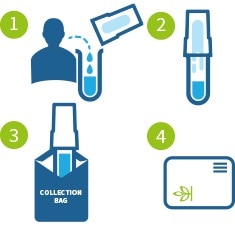How does AncestryDNA® work?
You may know that AncestryDNA® can tell you about your family’s origins using nothing more than a small saliva sample. But exactly how do we do it? How does DNA testing work and what goes on behind the scenes as we transform your DNA sample into your ethnicity estimate, ancestor migrations, DNA matches, and traits?
Getting Started with AncestryDNA®
You can easily purchase AncestryDNA or AncestryDNA + Traits online. We’ll send you a DNA kit that includes a saliva sample tube, a pre-paid envelope to mail your sample to us, a unique registration code, and instructions for how to prepare your saliva sample.

Once you receive your kit, you will also need an online Ancestry® account, if you don’t already have one. Each AncestryDNA test must be linked to a unique account—one for each test. The only exception is tests for children and minors, which must be added onto the account of a parent or legal guardian.
Once the registration code for your DNA test kit is entered into your Ancestry account, the two are linked. Your Ancestry account will be where you manage and view your DNA test results and DNA matches, as well as your DNA traits, if you’ve selected that DNA kit option.
You can also choose to connect your DNA results to your existing family tree on Ancestry. (If you don’t yet have one, it’s easy to start building your family tree.)
Collecting and Submitting Your DNA Sample
Your sample tube is enclosed in your DNA kit. Although the science behind it is complex, using it is fairly straightforward.
Fill the tube with saliva, up to the line indicated. Don’t worry, it’s a small tube and isn’t hard to fill.
Once you have filled the tube, screw the provided cap on securely until a blue fluid is released from the cap into the tube. This is an additive designed to preserve your DNA and make the testing process easier and to ensure the quality of your test results.
Then shake the tube for five seconds to distribute the additive and seal it in the provided envelope.
Mail the envelope back to us. Postage is already included to send your sample via U.S. mail, so please make sure not to send it with a different carrier.

How AncestryDNA Analyzes Your DNA Sample
After we receive it, our lab uses a state-of-the-art process to isolate your DNA from your saliva sample. Our test uses your autosomal DNA, which provides the most complete genetic picture of you compared to other types of DNA tests. Whereas the mitochondrial DNA used in some tests only shows your matrilineal heritage, or your biological female ancestors. Y-DNA tests only show patrilineal, or male ancestors and can only be taken by biological men or male relatives.
An autosomal DNA test, the kind that we use at AncestryDNA, lets us see both sides of your family and can be taken by anyone. It also lets us find information about you across much more of your DNA, scrutinizing hundreds of thousands of DNA positions, or markers, for a more detailed picture of who you are and where you’re from.
DNA Markers and What They Can Tell Us
Those markers that we look at weren’t chosen at random. They are places in your DNA where people differ slightly, called “single nucleotide polymorphisms,” or SNPs. You inherited your DNA from your parents, including those SNPs, so we can use their presence—or absence—to trace your ancestors back in time.

Calculating Your Ethnicity Estimate
AncestryDNA has spent years assembling a huge database of DNA samples, collected from people with deep ancestral roots in certain geographic regions. This “reference panel” of samples helps us identify patterns of SNPs that distinguish people from different regions around the world. If we also find those patterns in your DNA, it can reveal an ancestral connection to people from that region. That allows us to build your ethnicity estimate.
Drawing Even More Information from Your DNA
We can also use these SNPs to compare your DNA to the DNA of other people in our database. This lets you find family connections—people with whom you share lots of DNA in common. By combining this data with historical records and family trees, we can identify more than 2,600 different genetic populations (or regions), which can tell you about the origins and migration patterns of your ancestors in even greater detail.
Are you ready to learn what your DNA says about your ethnicity? AncestryDNA® or AncestryDNA® + Traits can help you along your path of discovery.